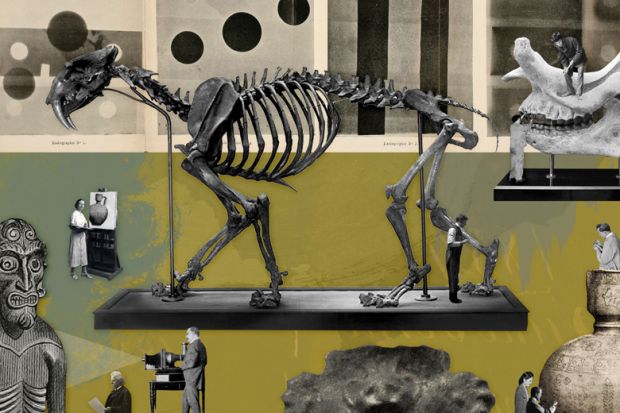Over the course of the 19th century, universities diversified. New ambitions and disciplines often demanded collections, just as new techniques today require dedicated laboratories. University museums were established, and their contents grew rapidly as scientific travel, anthropological fieldwork and art collecting brought together extraordinary assemblages of artefacts, works and specimens.
University museums came to be numerous, highly varied in scope and scale, and today embrace about a third of the UK’s collections officially designated as nationally and internationally significant. Yet disciplines changed, and so did understandings of method and evidence. Collections’ connections with teaching and research shifted and, in some cases, lapsed. At worst, university museums suffered a downward spiral: as displays became less relevant, less use was made of them, and the case for renewed investment diminished.
In the late 20th century, as public museums became more accessible and engaging, university collections risked falling between stools. Their public programmes were often poorly resourced, but neither did relatively inaccessible collections amount to effective teaching resources.
In fits and starts over the past 20 years, the landscape has changed, decidedly for the better. Within university museums, it has been recognised that there is not so much an invidious choice between public and academic engagement as a wide scope for fertile interplay.
A “material turn” has seen many disciplines rediscover the artefact, the physical specimen, the visual image and the historical scientific instrument. The collection – the original expression of “big data” – offers understandings of culture, society and biodiversity that cannot be arrived at through texts, archives or statistics. Digitisation and online access have motivated growing numbers of students, researchers and members of the public to study the actual stuff. The impact agenda has alerted researchers to the value of the museum exhibition as experimental medium and dissemination opportunity. And contemporary artists – more prominent in society and the media than ever before – are increasingly interested in historic collections not merely as sources of inspiration but also as places in which they might create interventions (interactions with existing artefacts) or site-specific works.
University museums, understood as object laboratories, enable not only traditional practicals but also an encounter with methodologies of material culture, salient to students in many fields. Museums underpin a new wave of research projects, ranging from textile histories to indigenous intellectual property and science education. The global range of their collections creates scope for global partnerships.
They also offer students a host of volunteering opportunities, and can help to widen participation by giving those who are not yet students a sense of the excitement of enquiry. In so far as they are welcoming and interesting, museums make towns and cities better places to live in and to visit, helping universities contribute to local communities and economies.
Yet none of this can happen unless collections are made accessible and are actively interpreted. Collections managers maintain cataloguing systems and know where the stuff is. Curators research, exhibit, reinterpret and update displays. School visits require education staff and resources such as teachers’ packs. Without marketing, the public won’t know that the museum is there, and won’t come.
In this context, it’s good news that the Higher Education Funding Council for England is reviewing the allocation of its fund to support what museums do for higher education beyond their institutions, and for the broader public. Given the ebullience of the sector, the selection panel, chaired by Diane Lees, director general of the Imperial War Museum, has an unenviable task. It is a pity that the size of the fund – £10.4 million a year, currently shared among 31 museums across 18 universities – is so modest, and that inflation will continue to erode its real value. Yet the allocation has been of decisive importance, helping university museums to leverage much more support from varied sources – including, most importantly, their host universities.
University museum directors will be preoccupied over the next few weeks with preparing compelling cases for the renewal, expansion or first-time award of grants. But there are deeper challenges that they and their university leaders need to address, sooner rather than later. Are curators able to teach and undertake research, unlocking the potential of collections for students, academic colleagues and prospective international partners? Are often vast collections adequately catalogued, and are catalogues sufficiently accessible to meet the democratic standard of open data? Are physical collections themselves accessible through study centres, such as Glasgow’s Kelvin Hall, that could become powerhouses of object-based teaching and research? And, while many universities have preferred to “embed” museums in specific departments, could it be that the somewhat unruly cross-disciplinary stimuli that collections offer is most effectively empowered by some level of institutional autonomy? It is notable that the most organisationally effective and successful university museums operate on this basis.
All these questions have become particularly vital now that university museums have regained their place at the heart of ambitious experimentation across the arts and sciences.
Nicholas Thomas is director of the Museum of Archaeology and Anthropology in Cambridge. His most recent book, The Return of Curiosity: What Museums are Good for in the Twenty-First Century, was published this month by Reaktion Books.
POSTSCRIPT:
Print headline: Material changes
Register to continue
Why register?
- Registration is free and only takes a moment
- Once registered, you can read 3 articles a month
- Sign up for our newsletter
Subscribe
Or subscribe for unlimited access to:
- Unlimited access to news, views, insights & reviews
- Digital editions
- Digital access to THE’s university and college rankings analysis
Already registered or a current subscriber? Login






